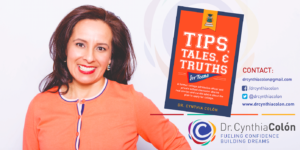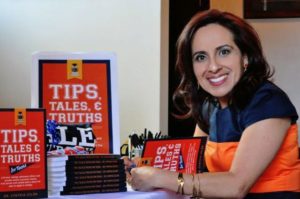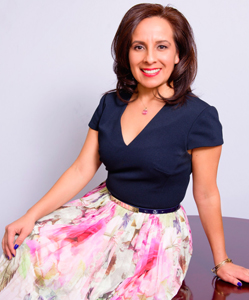The Latino Author is featuring published author Dr. Cynthia Colón. This is Dr. Colón’s first book and covers candid responses to a hectic process of becoming an author. I believe you’ll be impressed with the information she has chosen to share with our readers.
 Please tell our readers something about your background such as where you grew up, where you currently reside, or if you have another profession other than being a writer?
Please tell our readers something about your background such as where you grew up, where you currently reside, or if you have another profession other than being a writer?
I grew up in Bellflower, California, and I am a proud alumna of Bellflower High School. It was at Bellflower High School that I knew I wanted to work in schools. My mentors there came in the form of administrators, student council and cheerleading moderators, and teachers. I loved it. I loved everything about high school. Looking back now, when I was elected as the commissioner of assemblies and rallies and later as the student body president, I found what I was good at and what brought me joy: public speaking and inspiring others. My journey led me to career path in student affairs at USC, Barnard College, and Vassar College. From there I switched to the high school side as a private school college counselor, assistant academic dean, dean of students, and a high school principal.
What inspired you to write Tips, Tales, & Truth for Teens?
I have attached my Afterword. There is nothing better to explain how this book came to be.
For any high school senior, April is filled with extreme highs and extreme lows. Looking back on my own life, April has also served as a point of complete elation and severe heartache. April served as the month I received my first job offer with Vassar, and four years later, I accepted my position at Marymount High School, both experiences elicit emotions of pure joy. And in complete contrast, some of the people who have mattered the most to me have April birthdays, but for various reasons, they are no longer in my life.
On April 12, 2014 we laid my father, Benjamin G. Colón, to rest. He was 62 years old. One year later, I was in the final stages of signing paperwork to file for divorce. Death and divorce kicked me in the pants and brought me to my lowest point.
In April of 2016, I was on Easter Break, and in the quiet space of my head and my home. I had no choice but to face what I had avoided for nearly one year; myself. That week, I woke up every morning to my new routine; rise out of bed, read daily prayers, and get outside. I ran the streets of West Hollywood and Beverly Hills and hiked the trails of Griffith Park, all while listening to my new “girl power” play list. I did anything to keep busy and keep me from crying, but, the harder I ran, the harder I cried. What was I to do? I would not allow the pain of the last 24 months define me, but I was determined instead for that deep cut to inspire my best self.
I began to write. At first it was thirty minutes, but then I could write for hours. It was cathartic. I uncovered old journals, found what I called “Dean Diaries,” and gawked when I discovered my weekly entries in my first year as principal. I even found old speeches I had delivered in high school. I used everything for inspiration and kept writing.
A running routine provided time to think and listen to my inner voice. Somewhere along the way came the title Tips, Tales, and Truths. But, what did that look like? At first each would be its own section. The idea continued to evolve and I continued to write.

As my Saturday morning run merged from Santa Monica Blvd onto Melrose Place, I couldn’t wait to get home. I walked into my condo, my turquoise running tank damp with sweat, and Elvis jumped onto the couch to welcome me home. I grabbed a tall glass of water and sat in my inspiration chair on the balcony. The Picasso-esque chair is my favorite gift from my father, and on this day, I know he was present. Resting my legs up on a chair in front of me, Elvis curled up between my feet. I wrote and wrote until Tips, Tales, & Truths for Teens was born.
I am first generation to college. My parents had no idea how to help me access a four-year institution, but they supported my dream. How I ended up working at some of the most elite institutions is kind of crazy. Working at Barnard, Vassar, attending Columbia, and guiding the girls at the exclusive Marymount opened my eyes to a world I did not know existed. Through those experiences I realized just how unprepared I was when I attended USC. Talk about level playing field – not even close. Thank God I was oblivious to this fact at the time.
Tips, Tales, & Truths for Teens emerged because of a simple goal: to bring the knowledge I have had the privilege of experiencing to the masses. Who would I be if I did not otherwise serve all of the communities from which I come and those of which I have experienced? This is a calling, a duty, and an expectation of myself to inspire as many students as possible to discover just how big they can dream. While I acknowledge that college is not the path for everyone, I completely believe that it is my education that has opened so many doors.
Both my mother and father instilled in me tremendous self-confidence that I did not appreciate until now. In my darkest days, I had lost that strong sense of self, but it is through this project that I found my authentic self, my authentic voice, and my authentic why. My April ended with complete elation and joy. Now I can eat ice cream.
I sincerely look forward to hearing about your April celebrations to come!
Can you tell us what challenges you encountered while putting together this book?
The challenges I encountered were more personal. While I have known I had at least one book in me for years, in many ways I never thought of myself as a writer. In high school I was rejected when I applied to work on the school yearbook. At USC, I was rejected to the school of journalism. The message I received was simple, “You are not a writer,” or “You are not good enough.” The soundtrack we play in our head can be more debilitating than almost anything else. I consciously fought against that every single day.
After this book, do you see yourself continuing in the writing field, and if so, do you see yourself expanding out to other genres besides non-fiction?
As I sit here answering this question, I am anxious to get back to writing. I am on a 10-week break. I am temporarily home to visit family, have the book launch, network with the educators I know, and refuel myself for the next project. And as each week passes, I am more inspired and excited for the next several books. My dream is to continue writing a series of Tip, Tales & Truth books for the college admission essay, for the high school athlete, for his school parents, etc. Honestly, the possibilities are endless.
What were some of the writing traps you found as you wrote this book? Was it personal or mechanical?
Much of this question is answered in #3, but I will say this: for me this book is extremely personal. If there were any “traps” – they were personal. Each character is based on real life students and/or a combination of characters I have encountered in my life. Recalling and retelling stories often brought me to tears, tears of sadness, tears of joy, or tears of empathy for the character.
As I said at the book launch, I wrote each tip and truth from my head in order to offer concrete tips and college admission truths for teens and parents. I wrote each tale from my heart. I carefully crafted each character to offer 33 relatable lessons for teens.
I began writing on August 1, 2016 and Tips, Tales & Truths for Teens was first available on Amazon on May 9, 2017. This book is my “baby.”
Did you rely on other authors to assist you with this endeavor, or did you tackle it all on your own?
I tackled this project on my own. When I began writing in August 2016, I did not know when or how this would become a book, but I just kept writing. It was my cousin who connected me with another author, Jackie Camacho-Ruiz with JJR Marketing, who could and eventually did help me get the book published.
I turned over 38 tales before Christmas 2016 and received a 12-page analysis in January. What was working and what needed more thought and work.
The feedback came on a Friday and I was terrified to open the document. I waited until very late on Sunday and finally read my fate. I will never forget what Michele, the book developer, said in her notes and on the phone later that week, “One of the hardest things to do is for an author to find their voice.” She explained that readers want to feel that they know the author and that author is honest and authentic throughout the book. “And you have that already. I feel like I know you and we have never even met,” in those words, Michele gave me the confidence I needed to continue. The soundtrack that I was NOT a writer was finally being erased.
How and why did you choose the structure for your book (how did you balance the material you chose)?
Again – with Michele’s help – the biggest weakness of the “book” before Christmas was that there was no structure. With her help, we brainstormed together, and alas I came up with “YOUR Grand Plan.” Each chapter is a separate “plan.” Your Four-Year Plan, Your Pre-Application Plan, Your Resume Plan, Your Leadership Plan, Your Self-Improvement Plan, Your Senior Year Plan, Your New Plan Awaits.
The table of contents could not be more “me.” I am a planner. I get up every morning and make a plan of attack and make an minute to minute schedule for the day, allotting X amount of minutes per task that must be completed. I don’t allow “play” until the list is complete. So YES – I love the structure of the book.
What was the best and worst part of writing this book?
Best: This was a cathartic process for me. After the death of my father and divorce, I simply needed to escape my life and find my true calling. I believe I found it.
Worst: Same. This was a cathartic process and at times it was painful. The writing was not painful, but the unknown was painful. What would come of this writing? Was I on the right track? Am I doing what I’m supposed to do? Will any one person be better off because I wrote this book?
Who and/or what inspired or influenced you to write? Do you have a mentor?
Please see the Afterword from question two.
I was surprised to see, through old journals, speeches, and weekly principal memos, just how long I had been writing. I have been delivering “speeches” since high school.
As for mentors, I have many mentors that I stay in touch with, most of whom are older women I have met along the way at the various institutions I have attended and worked. None are authors, but most are educators and/or leaders.
If you could have dinner with any author, who would that be, and what question would you love to ask them?
Alison Weir – Q: Describe the process in which you use to research each queen for each new book. Q: Which do you enjoy more, the research or the writing?
Alisa Valdes-Rodriguez – Q: Describe the process you use to develop each character and develop the individual voices in each chapter.
What are some of the roadblocks you’ve encountered in writing this book? It is marketing and/or publishing? Please elaborate.
Once I found Jackie Camacho-Ruiz, the publishing part was fairly easy with her guidance. Now – we are just beginning the marketing and national campaign. This is tough and will take monumental efforts to get this book in the hands of every teen that needs it. I’m committed. This is my mission in life.
What I think most people don’t know is that this takes time, effort, investment.
What advice do you have for our readers in beginning an endeavor such as this?
Keep writing. Be consistent. If you can write for 15 minutes or 115 minutes per day, do it. Writing takes practice in order to hone the skill, find your voice, and discover a rhythm. In the beginning it could take me 3-4 days to draft one TTT between 1000-1200 words. By the end it took 3-4 hours. Keep writing.
What is the message that you hope your readers will take away with them after reading your book?
Three messages: 1 – 90% of the college application happens before senior year. 2- Teens have control over 90% of the college admission process. 3 – With a plan, anything is possible, so get started!
What would you say is the most important element in writing a good book?
One – Find YOUR authentic voice. If you are honest, readers will feel that.
Also – write what you know. This will help with # 1.
Lastly, can you tell us about any future projects with regards to writing that may be on your horizon?
My dream is that Tips, Tales & Truths becomes a brand. I have a series of books in mind, but the most immediate is:
Tips, Tales & Truths for the College Admission Essay
TTT for High School Parents
TTT for School Leaders




